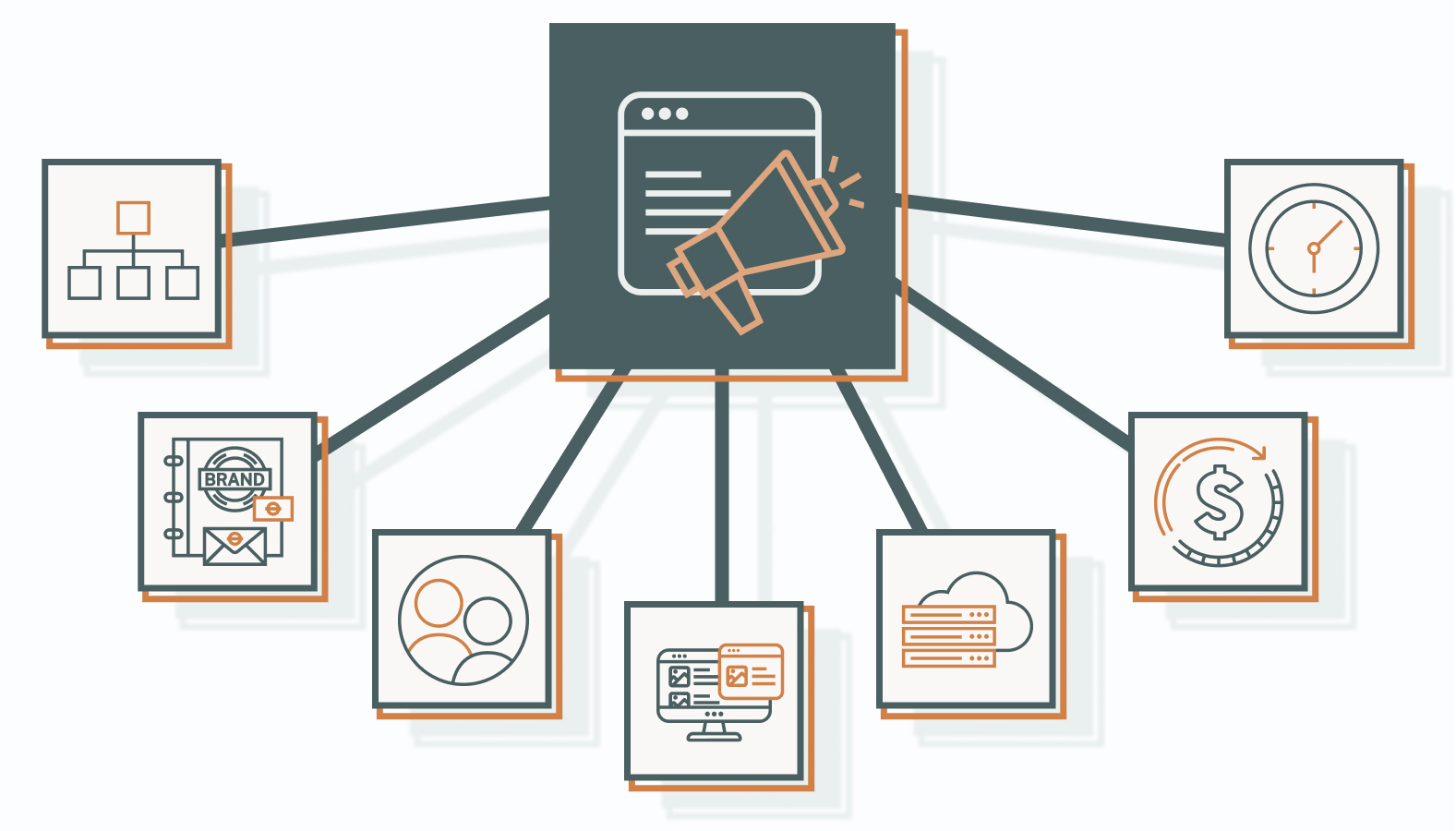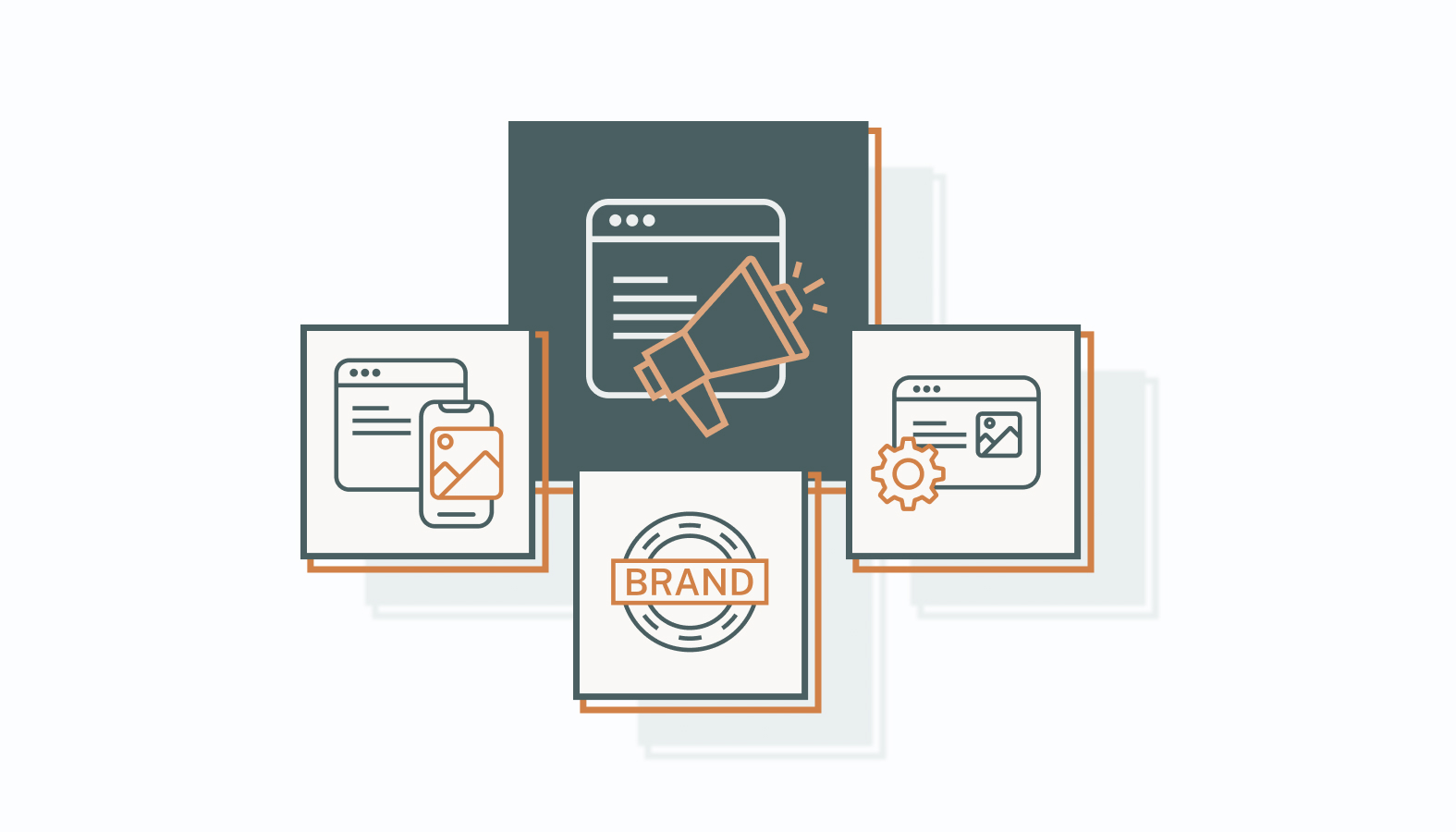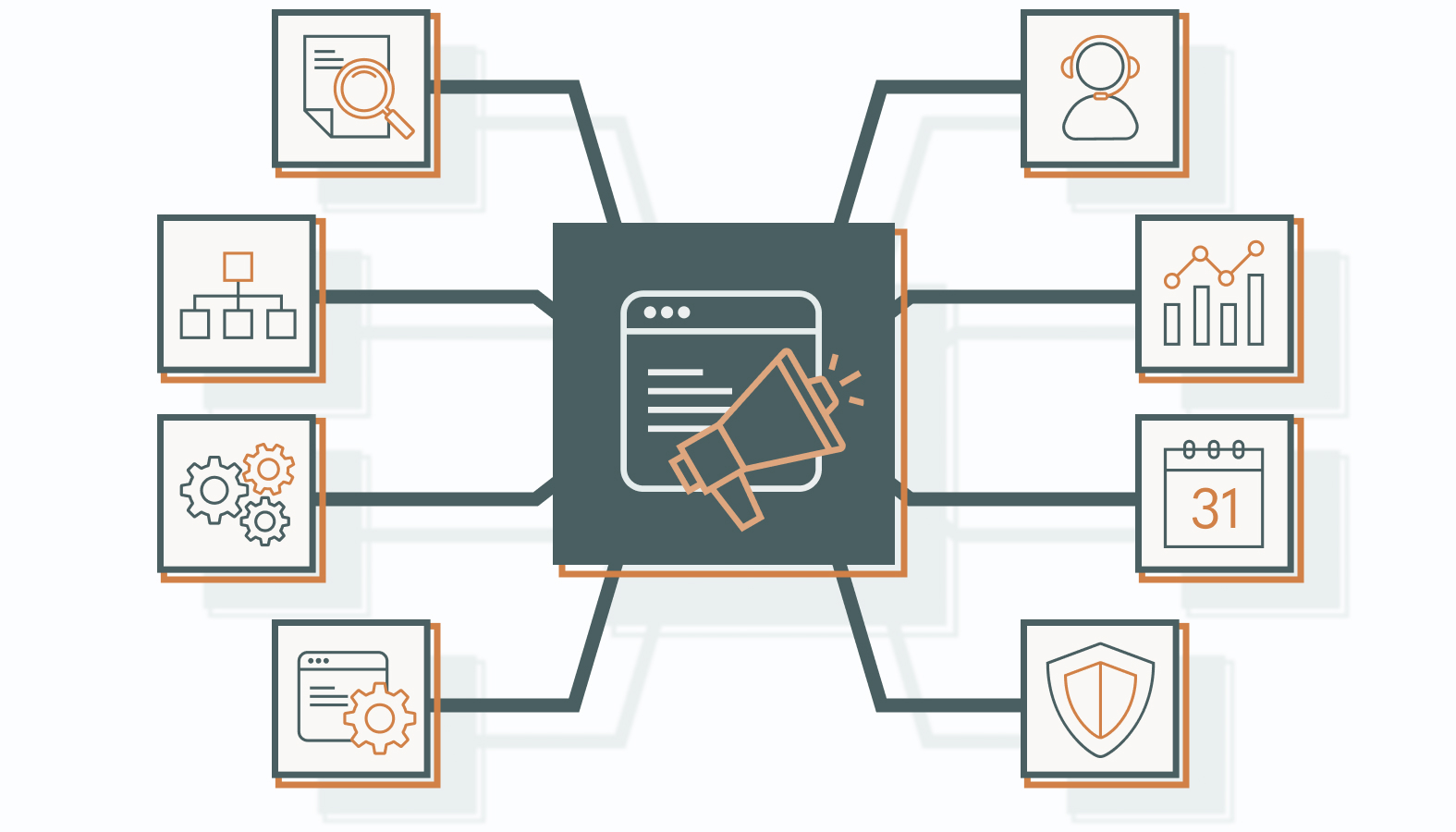Imagine trying to find a specific needle in a giant haystack. Now, imagine that the haystack is made up of thousands of marketing assets—images, videos, logos, and more.
That’s the reality for many businesses today.
It can be daunting to keep track of all these assets, ensure they’re current, and adjust them to align with your brand.
In this guide, we’ll show you how to tackle this challenge head-on. We’ll dive into how to set up a solid marketing asset management (MAM) system. This system will be your digital toolbox, helping you quickly organize, manage, and find assets quickly. We’ll also share practical tips to keep your assets consistent and up-to-date.
How to Make the Most of Your Marketing Assets
A successful marketing strategy depends on how well you manage your marketing assets.
A Simple Guide to Marketing Assets
Marketing assets are the essential tools you use to communicate with your audience. They include everything from images and videos to logos, copy, and templates.
Each type of asset plays a crucial role in promoting your brand and engaging your customers.
- Images: High-quality photos or graphics that capture your brand’s personality.
- Videos: Engaging content that can explain, demonstrate, or entertain.
- Logos: The visual symbol that represents your brand identity.
- Copy: Written content like blogs, articles, and social media posts.
- Templates: Standardized formats for consistent communication.
- Digital Files: Documents, presentations, and any other digital content.
How Managing Marketing Assets Has Changed Over Time
Technological advancements have transformed the way we manage marketing assets. In the past, marketers relied on physical storage or simple digital folders, which were often inefficient and error-prone.
Today, we have powerful tools like:
- Cloud Storage: Secure, scalable, and accessible storage for all digital files.
- Digital Asset Management (DAM) Systems: Sophisticated platforms for organizing, retrieving, and sharing assets.
- Automation Tools: Software that automates tasks like categorization, tagging, and updating, saving time and reducing errors.
Past Challenges vs. Current Solutions:
- Accessibility: Gone are the days of searching through physical files or disorganized folders. Cloud storage now provides easy access to assets anytime, anywhere.
- Collaboration: Instead of sending assets back and forth via email, DAM systems enable seamless, real-time collaboration among teams.
- Efficiency: Manual processes were time-consuming and prone to errors. Automation and advanced software have streamlined asset management, significantly improving efficiency.
By adopting these modern tools, businesses can ensure that their marketing assets are managed and optimized for maximum impact.
Why Marketing Asset Management is Important
Effective marketing asset management (MAM) is necessary for modern marketing. It helps keep your marketing materials organized, easy to find and used to their best advantage. Let’s see how MAM can improve your marketing.
Streamline Your Workflows
One of the biggest benefits of a robust MAM system is how it simplifies your work.
By keeping all your marketing materials in one place, MAM lets you find what you need, when you need it. This means less wasted time and fewer mistakes, as you can easily reuse existing assets instead of creating new ones.
Imagine a marketing team working on a new campaign. With a MAM system, they can effortlessly find high-quality images, approved copy, and design templates from past projects. This helps teams stay organized and focused, accelerating project timelines and improving overall productivity.
Ensure Consistent Branding
Branding thrives on consistency. A MAM system helps maintain a consistent brand message across all channels by providing a central hub for all brand assets. This means your logos, colors, fonts, and other brand elements are used consistently, reinforcing your brand identity.
Imagine your company launching a global marketing campaign. With a MAM system, your team can easily access the latest approved brand assets, ensuring all content aligns with your brand guidelines. This consistency builds trust and recognition among your audience, strengthening your brand’s presence in the market.
Facilitate Seamless Collaboration
Teamwork across different teams and departments is common in today’s interconnected world.
MAM tools facilitate collaboration by allowing multiple people to access, share, and edit marketing assets in real-time. This smooth interaction promotes cross-functional teamwork and speeds up content creation.
For example, a designer can upload a new visual to the MAM system, and the content team can immediately access and use it in their work.
Collaborating this way eliminates the delays and misunderstandings often associated with traditional asset-sharing methods and creates a more agile work environment.
Maximize Content Reuse
Repurposing content is a great way to get more value from your marketing efforts.
MAM systems make it easier to find and reuse existing assets, saving you time and money. Whether you’re editing a video for social media or turning a blog post into an infographic, MAM helps you get more mileage out of your content.
For example, a successful webinar can be transformed into short video clips, blog articles, and social media posts, all using assets stored in your MAM system. This approach not only extends the life of your content but also helps it reach a wider audience through different channels.
Centralize Access to Assets
A centralized MAM system makes it easier for everyone to access marketing assets, regardless of location. Organizing this way eliminates the time-consuming process of searching multiple storage locations and ensures everyone works with the most up-to-date materials.
Imagine a remote marketing team spread across different time zones. With a centralized MAM system, team members can access the same assets simultaneously, ensuring consistency and synchronization. This centralized approach streamlines operations and boosts overall team efficiency.
Boost Your ROI
Effective MAM can significantly boost your ROI. By optimizing asset usage, reducing costs, and speeding up time-to-market, MAM directly impacts your bottom line. Better asset management means less waste, more effective campaigns, and higher revenue.
Imagine the cost savings from reduced asset creation and the increased campaign effectiveness from consistent branding. These benefits demonstrate the financial value of investing in a robust MAM system.
Save Valuable Time
Time is a precious resource for any marketing team. MAM systems save valuable time by automating and streamlining processes. From asset tagging to workflow approvals, automation within MAM reduces manual tasks, freeing up your team to focus on more strategic activities.
For example, automated workflows can ensure that assets go through the necessary approval process without manual intervention. This speeds up content production, reduces the risk of errors, and ensures compliance with brand guidelines.
Types of Marketing Asset Management Systems
There are three main types of MAM systems: Digital Asset Management (DAM) systems, Brand Management Systems (BMS), and Content Management Systems (CMS).
Understanding the differences between these systems will help you select the best solution for your organization’s needs.
Digital Asset Management (DAM) Systems
DAM systems are designed to store, organize, and manage digital assets like images, videos, and documents. They provide a central hub for these assets, making them easy for teams to access and use effectively.
Key Features and Benefits of DAM Systems:
- Centralized Storage: All digital assets are stored in one place, ensuring easy access and management.
- Advanced Search: Powerful search capabilities with metadata tagging, allowing users to find assets quickly.
- Version Control: Tracks different versions of assets, ensuring that the most recent versions are used.
- Access Control: Role-based permissions to manage who can access, edit, or approve assets.
- Integration Capabilities: Seamless integration with other marketing tools and platforms for streamlined workflows.
DAM systems are especially beneficial for large organizations with vast digital assets, ensuring efficient management and retrieval of these resources.
Brand Management System (BMS)
A Brand Management System (BMS) is specifically designed to manage brand-related assets, such as logos, brand guidelines, and marketing collateral. It focuses on ensuring consistent branding across all marketing channels.
Unique Features and Advantages of BMS:
- Brand Guidelines: Houses comprehensive brand guidelines to ensure all marketing materials align with brand standards.
- Template Management: Provides pre-approved templates for various marketing materials, ensuring consistent branding.
- Approval Workflows: Streamlines the approval process for new brand assets, ensuring they meet brand standards before distribution.
- Analytics: Offers insights into brand asset usage and performance, helping refine branding strategies.
- Collaboration: Facilitates team collaboration to develop and maintain a cohesive brand image.
BMS is ideal for organizations prioritizing brand integrity and maintaining a consistent brand identity across diverse markets and channels.
Content Management System (CMS)
A Content Management System (CMS) creates, manages, and delivers digital content. While not solely focused on asset management, it is crucial in managing marketing content.
Key Features and Benefits of Using a CMS in Marketing:
- Content Creation and Editing: Provides tools for creating, editing, and publishing content, often with user-friendly interfaces.
- Content Storage: Centralized repository for storing various types of content, ensuring easy access and management.
- SEO Tools: Built-in tools for optimizing content for search engines, improving visibility and reach.
- Workflow Management: Streamlines the content creation and approval processes, ensuring efficient production.
- Personalization: Enables content personalization based on user behavior and preferences, enhancing user engagement.
CMS platforms benefit organizations that produce a high volume of content and need to manage it effectively across multiple digital channels.
Best Practices for Effective Marketing Asset Management
Follow these best practices to ensure your marketing materials are managed effectively.
1. Conduct a Comprehensive Asset Audit
Auditing your existing marketing assets is essential for understanding what you have and identifying any gaps or redundancies. This process helps you make informed decisions about asset utilization and future content creation.
Here’s a step-by-step guide to performing an asset audit:
- Categorize Assets: Group assets by type (e.g., images, videos, copy) and campaign.
- Evaluate Relevance: Assess whether each asset aligns with your current brand strategy and marketing goals.
- Identify Gaps: Note any missing assets that could enhance your marketing efforts.
- Document Findings: Create a detailed inventory of your assets, including metadata and usage history.
- Review Redundancies: Identify and eliminate duplicate or outdated assets to streamline your library.
2. Develop Clear Workflows and Processes
Having well-defined workflows and processes for managing marketing assets is crucial for smooth operations and efficient approval processes. Clear workflows ensure everyone understands their responsibilities and the steps required to manage assets effectively.
Practical Tips for Designing and Implementing Workflows:
- Map Out Processes: Create a visual map of your asset management process, from creation to approval and distribution.
- Assign Roles: Clearly define who is responsible for each step in the workflow.
- Set Approval Criteria: Establish criteria for approving assets to ensure consistency and quality.
- Automate Where Possible: Use automation tools to streamline repetitive tasks, such as tagging and categorizing.
- Regularly Review Workflows: Continuously assess and improve your workflows to adapt to changing needs and technologies.
3. Implement a Standardized Organization System
A standardized organization system is crucial for easy asset retrieval and collaboration. Consistent naming conventions, categorization, and tagging systems can significantly enhance the efficiency of your asset management.
Guidelines for Setting Up a Standardized Organization System:
- Naming Conventions: Develop a consistent naming convention that includes relevant information, such as date, project, and content type.
- Categorization: Group assets into categories based on type, campaign, or usage to facilitate easy access.
- Tagging System: Use tags to add metadata to assets, making them searchable by keywords, themes, or other criteria.
- Folder Structure: Create a logical folder structure that aligns with your organization’s hierarchy and workflows.
4. Select the Right Asset Management Software
Choosing the appropriate asset management software is crucial for aligning with your organization’s needs. The right software can enhance your asset management capabilities and improve overall efficiency.
Criteria and Tips for Evaluating and Selecting Software:
- Ease of Use: Ensure the software is user-friendly and intuitive for all team members.
- Integration Capabilities: Look for software that integrates seamlessly with your existing tools and platforms.
- Scalability: Choose software that can grow with your organization and accommodate increasing asset volumes.
- Features: Evaluate key features like search functionality, version control, access permissions, and analytics.
5. Offer Training and Support
Ongoing training and support are essential for ensuring team members can use the asset management system effectively. A well-developed training program can increase adoption and proficiency.
Suggestions for Developing a Training Program:
- Hands-On Sessions: Conduct interactive training sessions to familiarize team members with the software.
- User Manuals: Provide comprehensive user manuals and guides for reference.
- Continuous Support Channels: Establish support channels for ongoing assistance, such as help desks or chat support.
- Regular Updates: Offer refresher courses and update training materials as the software evolves.
6. Leverage Data to Measure Asset Performance
Using data analytics to track and measure asset performance can provide valuable insights into the effectiveness of your marketing assets. This information can help you optimize asset usage and refine your marketing strategies.
Practical Steps for Leveraging Data:
- Set Performance Metrics: Define key metrics to measure asset performance, such as engagement, conversion rates, and usage frequency.
- Analyze Data: Use analytics tools to gather and analyze data on asset performance.
- Optimize Asset Usage: Use insights from data analysis to optimize the use of high-performing assets and improve underperforming ones.
- Adjust Strategies: Continuously adjust your marketing strategies based on data-driven insights
7. Schedule Regular Audits and Cleanups
Regular audits and cleanups are essential for maintaining the relevance and quality of your marketing assets. This practice ensures that your asset library remains organized and up-to-date.
Schedule and Checklist for Periodic Audits:
- Review Asset Usage: Assess which assets are frequently used and which are not.
- Update Outdated Materials: Refresh or remove outdated assets to keep your library current.
- Remove Redundant Files: Eliminate duplicate assets to streamline your library.
- Document Changes: Keep a record of changes made during audits for future reference.
8. Enforce Security and Access Controls
Stringent security measures and access controls are vital for protecting your marketing assets. Ensuring that assets are secure and accessible only to authorized personnel can prevent unauthorized usage and potential data breaches.
Tips for Setting Up Access Controls:
- User Permissions: Define role-based permissions to control who can access, edit, or approve assets.
- Encryption: Use encryption to protect assets during storage and transmission.
- Regular Security Reviews: Regularly review security measures to identify and address vulnerabilities.
- Audit Logs: Maintain audit logs to track access and asset changes for accountability.
Empower Your Team and Boost ROI
In today’s fast-paced digital world, effective marketing asset management is no longer just a nice-to-have; it’s a necessity.
By implementing a robust MAM system and following best practices, you can streamline your marketing operations, improve efficiency, and maximize the value of your marketing assets.
Remember, your marketing assets are the building blocks of your brand’s communication. By managing them effectively, you can ensure that your brand’s message is consistent, engaging, and impactful.
Let’s Help Your Team Maximize Marketing Impact
If you’re eager to explore how implementing these strategies can transform your marketing efforts or simply have questions about where to start, we’re here to help.
Our experts are ready to provide honest, objective insights tailored to your unique needs.
Schedule a candid conversation with one of our experts », and let’s discuss how to take your marketing asset management to the next level. There’s no pressure — just a genuine opportunity to explore your options and see how we can support your goals.









